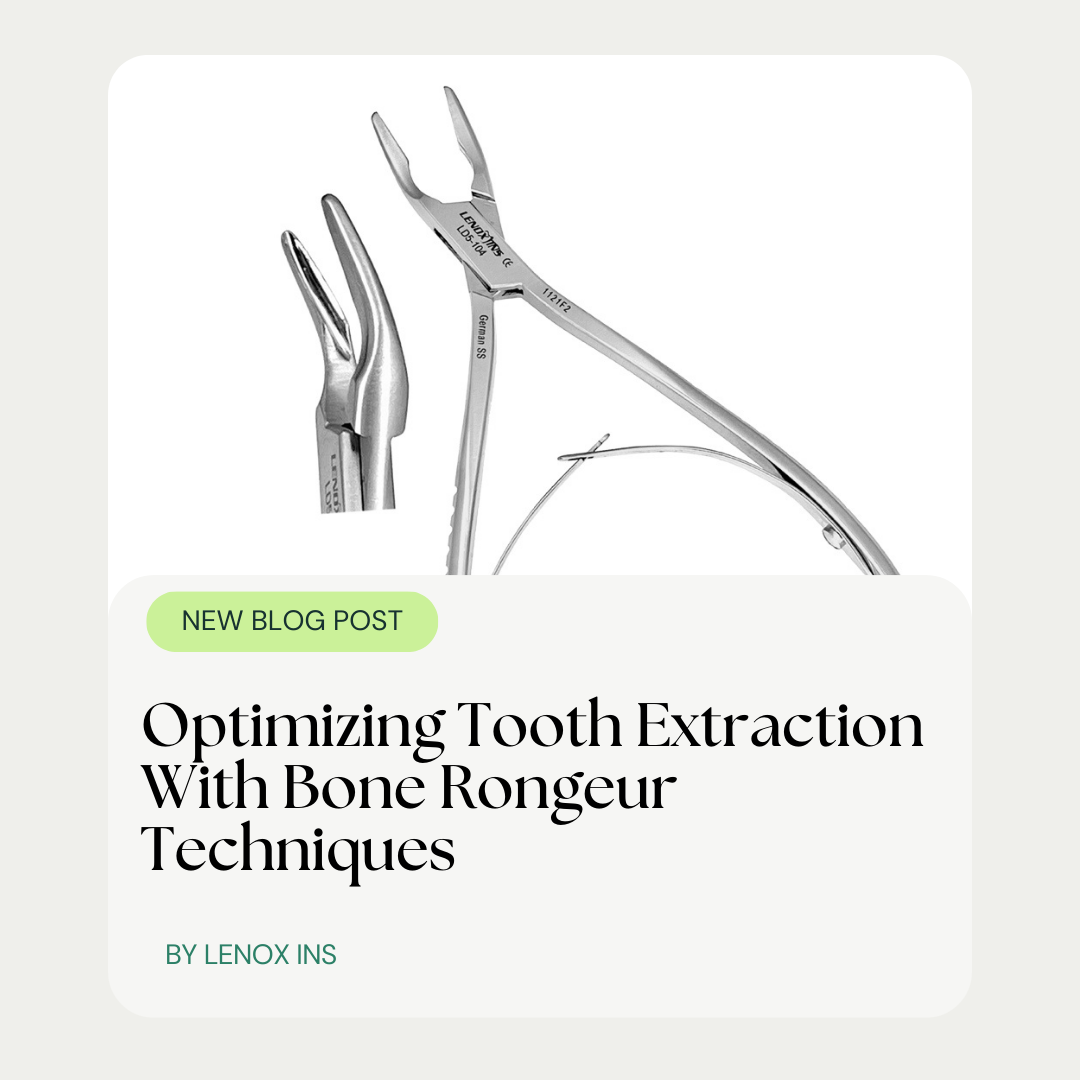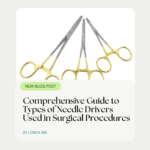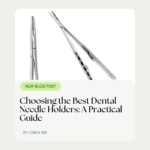Optimizing Tooth Extraction With Bone Rongeur Techniques
- lenoxinstro
- October 30, 2024
- Dental Instruments, Dental Surgical

Tooth extraction is a critical procedure in dentistry, yet it can come with challenges. Many practitioners struggle with ensuring minimal trauma to the surrounding tissue and bone. This article explores how optimizing tooth extraction with bone rongeur techniques can enhance the process. It will cover the benefits of using bone rongeurs, step-by-step techniques for their optimal use, and how to address common challenges. By understanding these methods, dental professionals can improve patient outcomes and streamline their extraction practices, ultimately easing frustration related to difficult extractions.
Key Takeaways
- Bone rongeurs improve precision and control during tooth extractions
- Different types of rongeurs are suited for specific surgical challenges
- Proper handling techniques minimize trauma and enhance patient comfort
- Ongoing training can significantly improve dental surgical outcomes
- Effective post-extraction care promotes faster recovery for patients
Understanding Bone Rongeurs in Tooth Extraction

Bone rongeurs are essential surgical instruments utilized in dental procedures, primarily during tooth extractions. They come in various types, each designed for specific applications in removing tissue and bone. Constructed from surgical stainless steel, bone rongeurs feature anatomy and design tailored for precision and effectiveness. The discussion will cover the definition and purpose of these tools, the different types employed, and their unique design features, emphasizing their relevance in optimizing extraction techniques.
Definition and Purpose of Bone Rongeurs
Bone rongeurs are specialized surgical instruments designed to efficiently remove tissues and bone during dental procedures, particularly tooth extractions. Their primary purpose is to aid in the removal of calculus and excess bone from the mouth and jaw, enhancing the dentist’s ability to create a clean and unobstructed site for extraction. With precision tips and robust construction, bone rongeurs ensure that practitioners can effectively address anatomical complexities, such as those found in the maxilla, ensuring successful outcomes and minimizing patient discomfort.
Types of Bone Rongeurs Used in Dental Procedures
Different types of bone rongeurs are utilized in dental procedures to facilitate tooth extractions and enhance accessibility to the surgical site. The most common designs include single-action and double-action rongeurs, which account for the varying degrees of force required by the surgeon when removing bone or soft tissue around the gums. These rongeurs, often resembling pliers, allow for precision manipulation, aiding in the effective cleanup of the extraction area while minimizing trauma to surrounding tissues.
| Type of Bone Rongeur | Design Feature | Common Use Case |
|---|---|---|
| Single-Action Rongeur | One lever action for simple control | Minimally invasive removals |
| Double-Action Rongeur | Two lever actions for increased force | Complex extractions and dense bone removal |
| Curved Rongeur | Curved design for improved access | Removing tissue within contoured areas |
Anatomy and Design Features of Bone Rongeurs
The anatomy and design features of bone rongeurs play a critical role in optimizing tooth extraction techniques. These instruments include elements such as precision tips that allow for careful manipulation at various angles, which is essential for accessing complex anatomical areas while ensuring patient safety. Additionally, the robust construction of bone rongeurs minimizes the risk of injury during procedures, while features like integrated curettes and needle holders enhance their versatility and effectiveness in removing bone and tissue with precision.
Bone rongeurs hold a vital role in tooth extraction, shaping the procedure’s success. Understanding their benefits will reveal why they are essential tools in dental practice.
Benefits of Using Bone Rongeurs for Tooth Extraction

Bone rongeurs offer several advantages for tooth extraction, significantly improving the precision and control during oral surgical procedures. Their design reduces trauma to surrounding tissues, lowering the risk of infection and enhancing patient comfort. Furthermore, effective use of these steel instruments promotes faster healing and recovery by minimizing flap complications, making them crucial tools in dental practices.
Improving Precision and Control
Bone rongeurs enhance precision and control during tooth extractions by offering a reliable grip and efficient design. With tips made from tungsten carbide, these instruments provide superior sharpness and durability, enabling practitioners to navigate complex anatomical structures with ease. This precision minimizes the risk of damage to surrounding tissues while improving the effectiveness of anesthesia application, leading to smoother procedures and better patient outcomes.
| Key Features | Impact on Tooth Extraction |
|---|---|
| Tungsten Carbide Tips | Increased sharpness and durability for precise cuts |
| Ergonomic Design | Improved grip and control during manipulation |
| Integrated Elevator | Facilitates optimal tissue handling before extraction |
| Easy Sterilization | Ensures instrument cleanliness and patient safety |
Reducing Trauma to Surrounding Tissues
Bone rongeurs significantly reduce trauma to surrounding tissues during tooth extractions. Their specially designed beak, often made of tungsten-coated stainless steel, allows for precise manipulation without excessive force, minimizing damage to adjacent gums and bone structures. This reduced trauma not only leads to less post-operative discomfort for patients but also lowers the risk of infection and promotes quicker healing times:
- Precision movement with tungsten-coated beaks reduces tissue trauma.
- Stainless steel construction ensures durability and reliability.
- Less trauma leads to improved patient comfort and faster recovery.
Promoting Faster Healing and Recovery
Utilizing bone rongeurs during tooth extraction surgeries, including the removal of wisdom teeth, promotes faster healing and recovery for patients. The precise design of these instruments minimizes trauma to surrounding tissues, reducing the risk of complications typically associated with traditional surgical methods. This strategic approach not only encourages swift recovery but also enhances overall patient comfort, addressing common concerns related to post-operative pain and discomfort.
Understanding the advantages of bone rongeurs sets the stage for the extraction process. Preparation is key, and knowing how to get ready can make all the difference.
Preparing for Tooth Extraction With Bone Rongeurs

Preparing for tooth extraction with bone rongeurs involves several critical steps. First, assessing the patient’s condition ensures a tailored approach for individual needs. Next, selecting the appropriate bone rongeur, whether utilizing a chisel or scissors, is essential for effective tissue management. Finally, proper sterilization and instrument setup help maintain a clean environment, removing any debris that could complicate oral and maxillofacial surgery.
Assessing the Patient's Condition
Assessing the patient‘s condition is a fundamental step in preparing for a tooth extraction procedure, especially when dealing with wisdom tooth or molar extractions. Dentists must evaluate the patient‘s dental history, overall health, and specific oral anatomy to ensure the appropriate surgical instruments, including bone rongeurs, are selected for the procedure. This comprehensive assessment helps identify any potential complications or contraindications, allowing for a tailored approach that enhances the efficiency and effectiveness of the extraction process while minimizing patient discomfort.
Selecting the Appropriate Bone Rongeur
Selecting the appropriate bone rongeur is crucial for ensuring effective tooth extraction, particularly in challenging anatomical regions like the mandible. Dental practitioners must consider the curvature of the extraction site and the specific tissue or bone type to be removed. Additionally, utilizing rongeurs equipped with retractors enhances visibility and access, enabling a more precise approach during the procedure, which ultimately benefits the patient by minimizing trauma and promoting quicker recovery.
- Assess the curvature and anatomical features of the extraction site.
- Choose a rongeur suited for the type of tissue or bone involved.
- Incorporate retractors to improve visibility and access during the extraction.
Sterilization and Instrument Setup
Sterilization and instrument setup are crucial steps in preparing for a successful tooth extraction using bone rongeurs. Proper sterilization of tools, including forceps and bone rongeurs, minimizes the risk of infections and ensures a clean surgical environment. Dental practitioners should follow established protocols for sterilizing instruments before each procedure, ensuring that both bone rongeurs and forceps are ready for safe and effective use:
- Assess the patient’s condition before preparation.
- Select the appropriate bone rongeur based on the extraction site.
- Utilize sterilization techniques for all surgical instruments.
- Set up the instrument tray for efficient access and use during surgery.
With preparation complete, the focus shifts to execution. Mastering the techniques of bone rongeurs will ensure a successful extraction and confident practice. Blumenthal bone rongeurs
Step-by-Step Techniques for Optimal Use of Bone Rongeurs

Proper handling and grip of bone rongeurs are vital for achieving optimal results during tooth extraction. Techniques for removing bone effectively will be discussed, focusing on minimizing trauma. Additionally, managing potential complications during the procedure will be covered to ensure the safety and comfort of the patient. These insights are essential for enhancing the efficacy of dental extractions.
Proper Handling and Grip
Proper handling and grip of bone rongeurs are crucial for ensuring successful tooth extractions. Practitioners should maintain a firm but gentle hold on the handles to provide optimal control during procedures, reducing the risk of inadvertent trauma to surrounding tissues. Mastering this technique enhances precision, allowing for careful navigation through intricate anatomical structures, thus promoting patient comfort and improving the overall effectiveness of the extraction process.
Techniques for Removing Bone During Extraction
When removing bone during tooth extractions, precise techniques are critical for maintaining safety and efficacy. Practitioners should begin by carefully assessing the extraction site to determine the amount of bone to remove. Using the bone rongeur with controlled movements allows the dentist to easily adapt to the unique anatomy of the patient, minimizing risk to surrounding tissues and promoting a smoother extraction process:
- Begin with a thorough evaluation of the extraction area.
- Employ controlled movements with the rongeur for accuracy.
- Adjust technique based on the patient‘s specific anatomical features.
Managing Complications During the Procedure
Managing complications during tooth extraction procedures is vital for ensuring patient safety and comfort. Practitioners should remain vigilant for signs of excessive bleeding or bone fragments that may complicate the extraction process. Utilizing bone rongeurs with care allows for precise tissue removal, and the dentist’s ability to adapt techniques in response to unforeseen challenges can significantly enhance outcomes, fostering a smoother recovery for the patient.
Even the most skilled hands can face challenges with bone rongeurs. Next, it is worthwhile to consider common obstacles and how to overcome them.
Addressing Common Challenges When Using Bone Rongeurs

Addressing common challenges when using bone rongeurs during tooth extraction is critical for ensuring successful outcomes. Key concerns include avoiding damage to adjacent teeth, effectively managing dense or brittle bone, and providing post-extraction care recommendations. Understanding these aspects enhances the precision of extraction techniques and contributes to a smoother recovery process for patients.
Avoiding Damage to Adjacent Teeth
To avoid damage to adjacent teeth during tooth extraction with bone rongeurs, practitioners must employ careful technique and visual assessment. Maintaining a clear line of sight to the extraction site helps in positioning the rongeurs accurately, ensuring that the force applied does not inadvertently affect neighboring teeth. Additionally, using a gentle approach and taking incremental actions can significantly reduce the risk of trauma to adjacent structures, leading to better patient outcomes and fewer complications post-procedure.
Dealing With Dense or Brittle Bone
Dealing with dense or brittle bone during tooth extraction requires careful technique to prevent complications. Practitioners should begin by assessing the density of the bone through imaging, which allows them to select the appropriate bone rongeur and approach. Utilizing rongeurs designed with sharper, more durable tips can aid in navigating challenging anatomical structures, allowing for precise removal of bone while minimizing trauma to surrounding tissues.
Post-Extraction Care Recommendations
Post-extraction care is crucial for ensuring a smooth recovery following a tooth extraction using bone rongeurs. Patients should be advised to bite down gently on gauze to control bleeding and replace it as needed until the bleeding subsides. Additionally, they should avoid vigorous rinsing or sucking motions that could dislodge the blood clot, while applying cold compresses to reduce swelling in the initial days following the procedure:
| Post-Extraction Care Tips | Purpose |
|---|---|
| Bite down on gauze | Controls bleeding and promotes clot formation |
| Avoid vigorous rinsing | Prevents dislodging of the blood clot |
| Apply cold compresses | Reduces swelling and provides pain relief |
Challenges can teach hard lessons. As skills grow, so does the need for continued learning.
Continuing Education and Skill Development

Continuing education and skill development are crucial for dental professionals aiming to optimize tooth extraction techniques with bone rongeurs. Training opportunities enable practitioners to enhance their abilities, while staying updated with the latest methods ensures the adoption of best practices. Successfully incorporating advanced bone rongeur techniques into everyday practice enhances surgical outcomes and ultimately improves patient care.
Training Opportunities for Dental Professionals
Dental professionals seeking to optimize tooth extraction techniques with bone rongeurs can benefit significantly from various training opportunities. Workshops and seminars focused on advanced surgical techniques provide hands-on experience in utilizing bone rongeurs effectively, ensuring practitioners stay up-to-date with the latest methodologies. Participating in continuing education courses not only enriches their understanding but also enhances their clinical skills, leading to improved patient outcomes:
- Workshops on bone rongeur techniques
- Seminars covering advanced extraction methods
- Continuing education courses for skill enhancement
Staying Updated With the Latest Techniques
Staying current with the latest techniques in bone rongeur use is essential for dental professionals dedicated to optimizing tooth extraction processes. Regularly participating in workshops, seminars, and continuing education courses enables practitioners to enhance their skills and learn about innovative methodologies that improve patient outcomes. By incorporating new findings and techniques into practice, dentists can address common challenges, streamline procedures, and ultimately provide better care for their patients: dental rongeur
| Training Opportunity | Focus Area |
|---|---|
| Workshops | Hands-on experience with bone rongeur techniques |
| Seminars | Advanced extraction methods and new technologies |
| Continuing Education Courses | Skill enhancement and best practice updates |
Incorporating Bone Rongeur Techniques Into Practice
Incorporating bone rongeur techniques into daily dental practice enhances extraction efficiency and patient outcomes. By applying skills learned from ongoing training and workshops, practitioners can better navigate complex extraction scenarios, particularly in areas with dense or challenging bone structures. Successful implementation of these techniques not only streamlines procedures but also addresses common complications, ensuring that patients experience reduced trauma and quicker recovery times.
Conclusion
Optimizing tooth extraction with bone rongeur techniques significantly enhances surgical precision and patient safety. By selecting the appropriate tools and techniques, dental professionals can reduce trauma to surrounding tissues, facilitate faster healing, and improve overall outcomes. Continuous education and training on rongeur use equip practitioners with the skills necessary to navigate complex cases effectively. Emphasizing the importance of these techniques ensures that dental practices can deliver superior care, ultimately benefiting both practitioners and patients alike.





